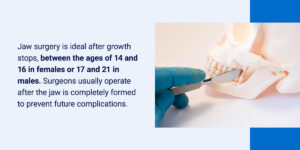Jaw surgery can provide relief from multiple jaw issues. We will walk you through each phase and keep you comfortable throughout treatment. Here’s what you can expect before, during and after jaw surgery.
Before jaw surgery
There’s plenty of preparation and pre-work that you must accomplish before your jaw surgery. Your doctor will use the following methods to acquire as much information as possible:
- X-rays
- Photographs of your jaw and teeth
- Teeth scans and computed tomography scans
- Impressions of your teeth
You may also need orthodontic treatment before your jaw surgery to prepare your teeth and mouth for the upcoming changes to your jaw. Your orthodontist may recommend braces or removing certain teeth. Before your surgery, you must avoid eating or drinking anything for the length of time your doctor tells you. You’ll be on a liquid-only diet after your surgery, so you will need to prepare by stocking up on nutrition drinks, milk, soup and other liquid food items.
During jaw surgery
During the procedure, your oral and maxillofacial surgeon will make incisions and adjust your jaw. The process will change depending on your needs, but you can talk to your surgeon to learn more about your case.
After jaw surgery
After surgery, you will experience some pain and swelling. Use an ice pack to help with swelling and discomfort during the first day after your surgery. The initial healing period is about six weeks, but it can take up to 12 weeks or longer to heal completely. We recommend taking two weeks off of school or work to rest. After surgery, you’ll have a plastic splint in your mouth that will help your muscles adjust to your new jaw position. Be sure to wear your splint at all times except when eating a meal or cleaning your teeth. You will most likely need orthodontic treatment after your surgery. This treatment will ensure your teeth stay straight and help you experience the best long-term results.


